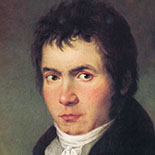 The Symphony No. 5 in C minor of Ludwig van Beethoven, Op. 67, was written 1804–1808. It is one of the best-known compositions in classical music, and one of the most frequently played symphonies.
The Symphony No. 5 in C minor of Ludwig van Beethoven, Op. 67, was written 1804–1808. It is one of the best-known compositions in classical music, and one of the most frequently played symphonies.
First performed on December 22, 1808 in Vienna’s Theater an der Wien, the work achieved its prodigious reputation soon afterward.
It begins by stating a distinctive four-note “short-short-short-long” motif twice:

The symphony, and the four-note opening motif in particular, are known worldwide, with the motif appearing frequently in popular culture, from disco to rock and roll, to appearances in film and television.
Since the Second World War it has sometimes been referred to as the “Victory Symphony”. “V” is the Roman character for the number five; the phrase “V for Victory” became well known as a campaign of the Allies of World War II. That Beethoven’s Victory Symphony happened to be his Fifth (or vice versa) is co-incidence. Some thirty years after this piece was written, the rhythm of the opening phrase – “dit-dit-dit-dah” – was used for the letter “V” in Morse Code, though this is probably also coincidental.
The Symphony No. 6 in F major, Op. 68, also known as the Pastoral Symphony (German Pastoral-Sinfonie), is a symphony composed by Ludwig van Beethoven, and completed in 1808. One of Beethoven’s few works containing explicitly programmatic content, the symphony was first performed in the Theater an der Wien on December 22, 1808 in a four hour concert.